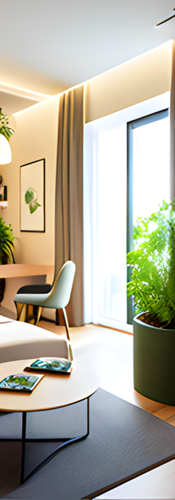BESPOKE TALK Series: Exploring the Benefits of Biophilic Design in Architecture.
- John Michael Jalandra

- Jan 24, 2023
- 3 min read
Updated: Apr 7, 2024

Ai Generated Images
Drawing inspiration from the wonders of nature, "biophilic design" endeavors to craft environments that exude both solace and inspiration. At its core, this approach stems from the concept of "biophilia," elucidating humanity's inherent yearning to be in harmony with the natural realm. By integrating principles derived from ecology and environmental psychology, "biophilic design" aspires to cultivate a profound bond between individuals and the bountiful expanse of the natural world, thereby augmenting their holistic well-being and enhancing the tapestry of their existence. It is worth noting that the realm of biophilic design extends beyond the confines of domestic or institutional edifices.
This concept has gained traction in the built environment in recent years. Buildings with a "biophilic design" have elements of nature brought inside to boost the health and happiness of the occupants and reduce the building's environmental impact. The addition of vegetation, running water, and windows is one example of this. Techniques include things like using natural materials like wood and stone and installing natural ventilation systems and green roofs.

Ai Generated Images
By using the principles of biophilic design to blend water features like beautiful fountains, peaceful pools, and tumbling waterfalls into the built environment, one can really improve the human experience and feel more connected to the natural world. This perfect mix of water features has a positive effect in many different areas, including both home and business design. In private areas, it creates a calm and restful atmosphere that helps people relax and feel better. On the other hand, it builds a sense of community and gives relief and comfort in business settings. Notably, adding water elements also has the added benefit of improving air quality by releasing negative ions that are good for you.
RESIDENTIAL BIOPHILIA
Ai Generated Images
Biophilic design is a concept in residential architecture that focuses on integrating natural elements into the design and building of dwellings. It stresses the use of natural materials such as wood and stone to produce a visually beautiful and aesthetically satisfying living environment.
Biophilic design entails incorporating natural elements like as plants, water features, and abundant natural light, in addition to employing natural materials. These aspects add to a feeling of connection with nature and create a pleasant and relaxing environment inside the house.
A green roof or a living wall, for example, might be included into the house architecture. A green roof is a rooftop garden or vegetation cover, while a living wall is a vertical plant-covered surface. These features provide various advantages, including better air quality (as plants naturally filter pollutants) and increased insulation (as plants naturally filter pollutants).
Ai Generated Images
COMMERCIAL BIOPHILIA
Ai Generated Images
Biophilic design is gaining popularity in commercial construction due to its positive impact on staff productivity and well-being. The integration of biophilic elements into commercial buildings offers numerous advantages.
Green roofs and living walls are notable features that bring significant benefits. Green roofs, which are gardens or vegetation covers on the rooftops, provide multiple advantages such as enhanced air quality, insulation, and effective stormwater management. They act as natural filters, purifying the air and reducing pollutants. Additionally, green roofs offer insulation properties, helping to regulate temperature and reduce energy consumption. They also assist in managing stormwater runoff by absorbing and slowing down rainfall, thereby alleviating strain on urban drainage systems.
Living walls, which are vertical gardens incorporated into the building's exterior, contribute to the overall well-being of employees. They serve as natural air purifiers, removing toxins and pollutants from the surrounding environment. Moreover, living walls help reduce the urban heat island effect by providing shade and cooling the building. Additionally, these visually appealing installations establish a direct connection to nature, creating a soothing and calming ambiance within the workplace.
Ai Generated Images
However, it is important to remember that the incorporation of biophilic design features should be addressed with care and balance. These aspects, if not handled appropriately or excessively, may have unforeseen negative implications, such as making areas seem confined or overpowering them with an excessive presence of nature. As a result, it is critical to create a balance between adding natural features and maintaining the functioning and overall design of the constructed environment.

In conclusion, adopting biophilic design concepts into both residential and commercial building has several benefits, including improved well-being and energy efficiency. As more research demonstrates the good impact of nature on human health and happiness, it is projected that biophilic design in building will gain appeal. However, great consideration must be given to the right use of biophilic design components in order to achieve the intended results while preserving a harmonic balance of utility and aesthetics.
Ar. Neil John Bersabe
Lead Architect
John Michael Jalandra
Content Writer
BERSABARC Design Studio 2023
Disclaimer: All of the photos are artificially intelligent art generated.














































